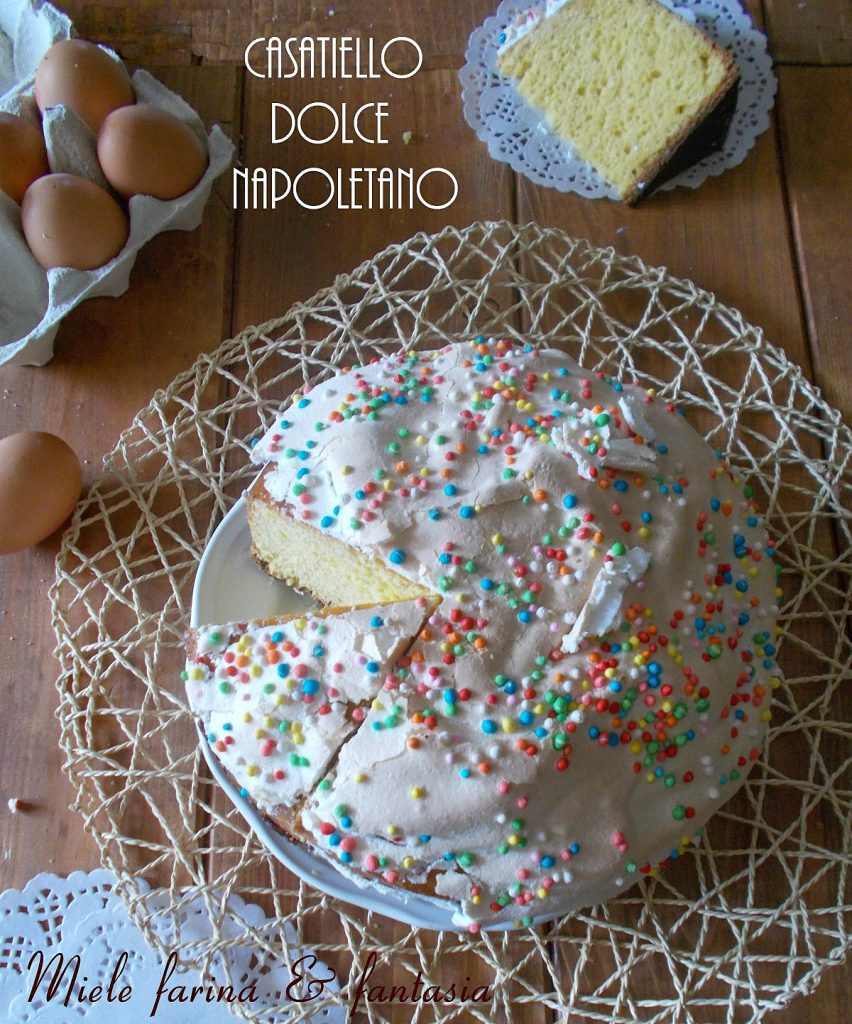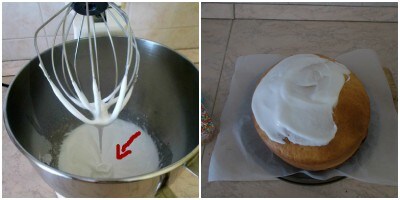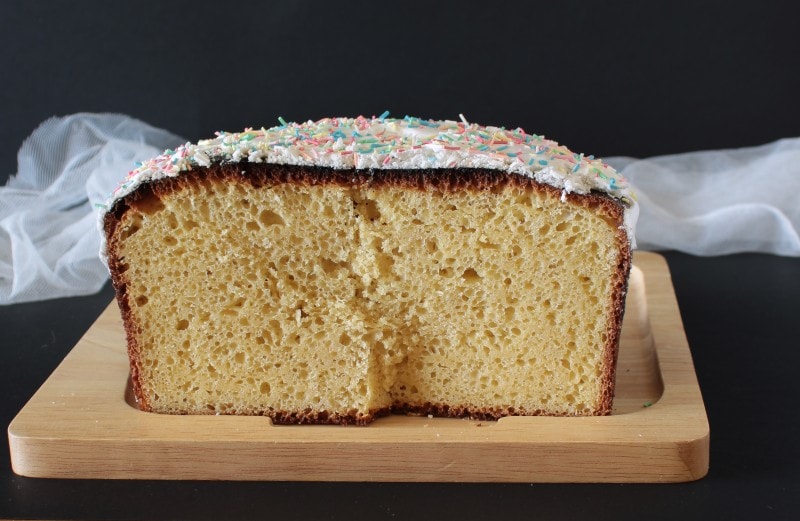Today I will talk to you about another typical recipe from my land, the sweet casatiello. Yes, there is also a sweet version of the Neapolitan casatiello, even though, in terms of dough type and ingredients, it has little in common with its savory “cousin.” In my family, it is traditional to prepare it both for Christmas and Easter. It’s a cake made with sourdough, sugar, eggs, lard (or butter), and flavors. Everything is topped and decorated with a delicious and crunchy royal icing glaze and colorful sprinkles. The inside of the sweet casatiello has a soft but, at the same time, more compact texture with a tighter crumb than a Christmas panettone (to make a comparison). In my family tradition, sweet casatiello must be tall and narrow; for this reason, the molds used have a circumference of about 8.66/9.45 inches wide and at least 4.72/5.51 inches in height. However, we can use the molds we already have at home; even those for bundt cakes are perfectly fine. The only two changes made to my family’s original recipe, specifically my grandmother’s, concern the use of a stand mixer instead of hands and the type of flour. My grandmother used weak flour with enormous yeast management problems, as weak flour has weak gluten and thus cannot withstand long rising times. However, thanks to her extensive experience with this type of cake and her very, very strong sourdough, she managed, with some concern and “races against time,” to make wonderful casatielli until she “discovered” Manitoba flour. Happy reading and happy sweet casatiello.
You are writing to me in large numbers, and I thank you very much for the trust. At the bottom of the recipe, in the notes section, I have included the procedure to suitably replace the sourdough with a pre-ferment made with brewer’s yeast (or so-called “biga”), to achieve an equally excellent result.

- Difficulty: Medium
- Cost: Medium
- Preparation time: 12 Hours
- Portions: 1 casatiello over one kilo
- Cooking methods: Oven
- Cuisine: Italian
- Seasonality: Easter Monday, Easter
Ingredients
- 500 g Manitoba Flour
- 100 g Sourdough
- 7 Whole eggs (medium)
- 200 g Sugar
- 50 g Lard
- 1 packet Vanillin
- 1 Vial of Orange Flower Water
- 1 tablespoon Strega Liqueur
- 1 tablespoon Rum or Limoncello
- Zest of 1 lemon
- 1 g Fine salt
- 1 Egg white
- 100 g Sugar
- 1 teaspoon Lemon juice
Tools
- 1 Mold
Preparation
With these doses, we can prepare a sweet casatiello of over one kilo. The mold I used is the traditional one, i.e., aluminum, round, 9.84 inches in diameter, and 3.94 inches high.
Refresh the sourdough (which must be strong and lively) as we are already accustomed to; however, I recommend hydrating it a little more to make it softer and facilitate the absorption of the strong flour and the egg. If not, don’t panic. It will suffice, in fact, to possibly add a second egg to the mixture.
When the sourdough has risen, take 100 grams and knead it with 100 grams of flour and 1 whole egg. As soon as the egg and flour have been fully absorbed, knead it briefly with your hands to give it a spherical shape. Make a cross cut on the surface, cover the first dough well, and let it rise until it doubles (at room temperature, it takes about 10/12 hours). It will not be necessary to work the three doughs for a long time; stop the mixer as soon as the ingredients are perfectly blended.
When the first dough has doubled, knead it with another 200 grams of flour and 2 whole eggs. As soon as the ingredients are blended, briefly work the dough with your hands (as described above). Let the second dough rise until it doubles (around 10/12 hours).
3) Proceed with the third and final dough. Add the remaining flour (i.e., 200 grams), the remaining eggs (one at a time), the sugar, the salt, the lard (which we can substitute with 50 grams of very soft butter worked into a cream with the tines of a fork), the flavors, the liqueur to the second dough. Since not all eggs are the same size and not all flours absorb liquids the same way, it may be necessary to have a few more or fewer eggs than I’ve indicated. In my case, the dough absorbed a total of 7 medium eggs. The final consistency of the dough must be very, very mushy, almost fluid. Once all the ingredients are perfectly absorbed, transfer the dough into the pan(s) we have already generously buttered and floured. Let it rise until it almost reaches the edge of the mold. Bake the sweet casatiello at 356°F for about 60/70 minutes in an already hot oven. It should become uniformly amber-colored. To check the baking, pierce the sweet casatiello with a skewer which should come out dry. During the last 5 minutes of baking, prepare the royal icing.

In a stand mixer, pour an egg white and start whipping it at high speed for about 15 seconds. At this point, start pouring the sugar, little by little, until the mixture appears shiny, very white, and rather dense; the icing, as it falls from the whisk, should “write” on the bottom, i.e., leave visible marks. If necessary, we can add a little more sugar. Flavor it with a teaspoon of lemon, orange, or tangerine juice. As seen in the photo on the right, once spread, the icing does not drip off the casatiello. Turn off the oven and immediately extract the cake. With a spatula, immediately cover the casatiello with the glaze (entirely or only the top). Sprinkle with colorful sprinkles and reintroduce the cake. In this way, the residual heat of the oven will dry and pasteurize the icing. The icing is ready as soon as it feels hard to the touch and has lost its shine (it takes about 10 minutes). The sweet casatiello keeps for days and days; in fact, it can be made even a week before the holidays and then stored in a cake cover or a bread bag. It will become better and better over time.


Many of you have asked me: here is my mold, 9.84 inches in diameter and 3.94 inches tall, but there are also narrower and taller or smaller ones, depending on your needs.

For those who do not possess sourdough
We can also use fresh brewer’s yeast, by preparing a pre-ferment (biga) with 5 grams of fresh brewer’s yeast, 100 grams of Manitoba flour, and 70 ml of water. Knead in a bowl and create a soft dough. Seal the bowl with plastic wrap. Let it double in volume before incorporating it into the other ingredients as if it were sourdough, just as described above. The biga will have a greater weight than the amount of sourdough I indicated, but it will not be a problem.

